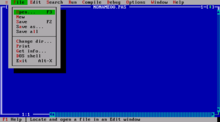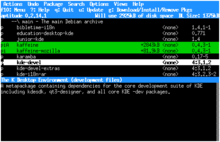Character-oriented user interface

As a text-based user interface are interfaces which have in the text mode are executed, but the screen still "flat" use and not line by line.
The term is used to distinguish on the one hand by the line-wise operating command line interface ( English command-line interface , CLI), on the other hand, on the graphical user interface ( English graphical user interface , GUI). The word is a retronym that was coined after the appearance of graphical user interfaces. In English there is the abbreviation TUI for English text-based user interface , which can also mean English tangible user interface .
implementation
The programmer only has the (typically 256 different) characters of a single character set available. Since the late 1980s, many newer TUIs have tried to imitate elements of the GUIs by using frames and other special characters to reproduce frames for windows or other elements such as menus , checkboxes, buttons, etc. Most of these newer TUIs can be operated with the mouse , but almost always all functions can also be accessed via the keyboard .
Input masks on mainframes often also have character-oriented user interfaces. In contrast to the character-oriented Telnet , the tn3270 protocol sends complete input masks to a terminal or a terminal emulation , which are filled out there and sent back to the mainframe via an input key.
Around 1990 Borland developed Turbo Vision as a DOS-based TUI framework. Under Unix-like operating systems, character-oriented user interfaces are often created with curses or ncurses . The program dialog provides many of the capabilities of ncurses, but they can be used without programming knowledge.
Rebecca Ruji Chapnik comparing text-based audio players:
- It looks and works much like a graphical user interface, except it's all ASCII — or perhaps ANSI, depending on your terminal. [...] This article, however, focuses on TUI rather than CLI applications. For many text-mode programs, Ncurses is the window (no pun intended) to usability.
Examples
- Audio player: cmus , mocp
- Chat: BitchX , irssi , ircII , WeeChat
- File managers: FAR Manager , Midnight Commander , Norton Commander , ranger
- Editors: emacs , nano , vi / vim , MS-DOS editor
- Email: mutt , pine / alpine
- HTML browser: lynx , left with successors, w3m
- Calendar: calcurse , wyrd
- Package manager: aptitude , YaST
- Word processors: Vim , WordStar
- Development environment: Turbo Pascal
- Games: Nethack , Snake , Tetris
- System programs: fdisk variations, configuration option menuconfig for the Linux kernel (which is called via make menuconfig ), partimage , top / htop
- Other: newsbeuter
In addition, most boot loaders and BIOS setup programs use character-oriented user interfaces. Many operating system installation routines are also TUIs.
See also
- User interface
- Console application
- Command line , command line interpreter
- Graphical user interface
- Menu (Computer) , drop-down list , drop-out menu
- Text mode
literature
- JW Chen, J. Zhang: Comparing Text-based and Graphic User Interfaces for novice and expert users. In: AMIA .. Annual Symposium proceedings / AMIA Symposium. AMIA Symposium. 2007, pp. 125-129, PMID 18693811 , PMC 2655855 (free full text). Quote: "The results show that the GUI interface was not better than the TUI for expert users."
- Park, Jonghyuk, and Nakhoon Baek. "A light-weight text-based user interface module for small embedded systems." Int. J. of Control and Animation 5.4 (2012): 169-174.
- Park, J. & Baek, N. Kim, JK & Joukov, N. (Eds.). "An Object-Oriented Programming Interface for Low-Tier Text-Based Windowing Systems." Information Science and Applications (ICISA) 2016, Springer Singapore, 2016, 481–487. doi : 10.1007 / 978-981-10-0557-2_48 Quote: "In this paper, we present an object-oriented implementation of the TUI windowing systems, also with object-oriented application programming interfaces. Our system is very simple and intuitive, with few amount of computing resource. It supports multiple windows, context menus, message boxes, and other user interface components, with graceful object-oriented application interfaces. "
Individual evidence
- ^ DI Clark, JD Newmarch: Application level user interfaces for various media . In: Technology of Object-Oriented Languages and Systems (TOOLS 32 Proceedings, Melbourne, Vic.) . 1999, doi : 10.1109 / TOOLS.1999.809411 : "In this paper, we focused on a small footprint, light-weight but efficient user interface toolkit. To overcome the memory limitations and lack of computing powers, after a sequence of experiments, we finally designed a text-based user interface (TUI) style toolkit, for low-tier embedded systems. "
- ↑ Chapnik, Rebecca: Rock Out with Your Console Out. In: Linux Journal. June 11, 2012, accessed July 22, 2016 .

